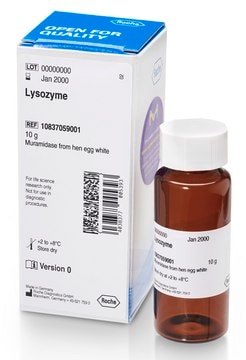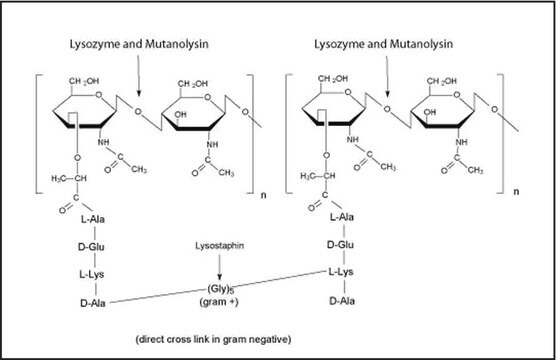SAE0152
Lysozyme from chicken egg white
free of DNA contaminants, suitable for Microbiome research, lyophilized powder, protein ≥90%, ≥40,000 units/mg protein
Synonym(s):
Lysozyme from chicken egg white, Mucopeptide N-acetylmuramoylhydrolase, Muramidase
About This Item
Recommended Products
biological source
chicken egg white
Quality Level
form
powder
specific activity
≥40000 units/mg protein
mol wt
single-chain 14.3 kDa
feature
DNA free
technique(s)
cell based assay: suitable
suitability
suitable for cell lysis
application(s)
cell analysis
shipped in
wet ice
storage temp.
−20°C
Looking for similar products? Visit Product Comparison Guide
General description
Lysozyme is a single chain polypeptide of 129 amino acids cross-linked with four disulfide bridges.1 It hydrolyzes b(1à 4) linkages between N-acetylmuraminic acid and N-acetyl-D-glucosamine residues in peptidoglycan and between N-acetyl-D-glucosamine residues in chitodextrin.2,3,4 The enzyme is often used for lysing bacterial cells by hydrolyzing the peptidoglycan present in the cell walls. Gram-positive cells are quite susceptible to this hydrolysis as their cell walls have a high proportion of peptidoglycan. Gram-negative bacteria are less susceptible due to the presence of an outer membrane and a lower proportion of peptidoglycan.
The enzyme is active over a broad pH range (6.0-9.0).
Lysozyme activity: ≥40,000 units/mg protein.
For isolation of nucleic acids, lysozyme has been used in the lysis peptidoglycan layer of bacterial cell walls.
The study of microbial communities has been revolutionized in recent years by the widespread adoption of culture independent analytical techniques such as 16S rRNA gene sequencing and metagenomics. Since DNA contamination during sample preparation is a major problem of these sequence-based approaches, DNA extraction reagents free of DNA contaminates are essential. This purified lysozyme preparation (SAE0152) is purified from chicken egg white, crystallized three times, dialyzed, and supplied as a lyophilized powder. Protein content by UV absorbance is ≥ 90% with the remainder (∼10%) being buffer salts such as sodium acetate and sodium chloride, and undergoes strict quality control testing to ensure the absence of detectable levels of contaminating DNA using 35 cycles PCR amplification of 16S and 18S rDNA using universal primer sets.
Application
- Lysozyme is used for the extraction of genomic DNA from bacterial cells.
- Lysozyme is used as an external standard for MALDI-TOF (matrix assisted laser desorption ionization-time of flight) mass analysis.
- Lysonzyme is used to prepare spheroplasts.
Biochem/physiol Actions
The enzyme is active over a broad pH range (6.0 to 9.0). At pH 6.2, maximal activity is observed over a wider range of ionic strengths (0.02 to 0.100 M) than at pH 9.2 (0.01 to 0.06 M).
Features and Benefits
The study of microbial communities has been revolutionized in recent years by the widespread adoption of culture independent analytical techniques such as 16S rRNA gene sequencing and metagenomics. Since DNA contamination during sample preparation is a major problem of these sequence-based approaches, DNA extraction reagents free of DNA contaminates are essential.
Unit Definition
Signal Word
Danger
Hazard Statements
Precautionary Statements
Hazard Classifications
Resp. Sens. 1
Storage Class Code
11 - Combustible Solids
WGK
WGK 3
Flash Point(F)
Not applicable
Flash Point(C)
Not applicable
Regulatory Listings
Regulatory Listings are mainly provided for chemical products. Only limited information can be provided here for non-chemical products. No entry means none of the components are listed. It is the user’s obligation to ensure the safe and legal use of the product.
JAN Code
SAE0152-1G:
SAE0152-BULK:
SAE0152-1G-PW:
SAE0152-VAR:
Certificates of Analysis (COA)
Search for Certificates of Analysis (COA) by entering the products Lot/Batch Number. Lot and Batch Numbers can be found on a product’s label following the words ‘Lot’ or ‘Batch’.
Already Own This Product?
Find documentation for the products that you have recently purchased in the Document Library.
Our team of scientists has experience in all areas of research including Life Science, Material Science, Chemical Synthesis, Chromatography, Analytical and many others.
Contact Technical Service






